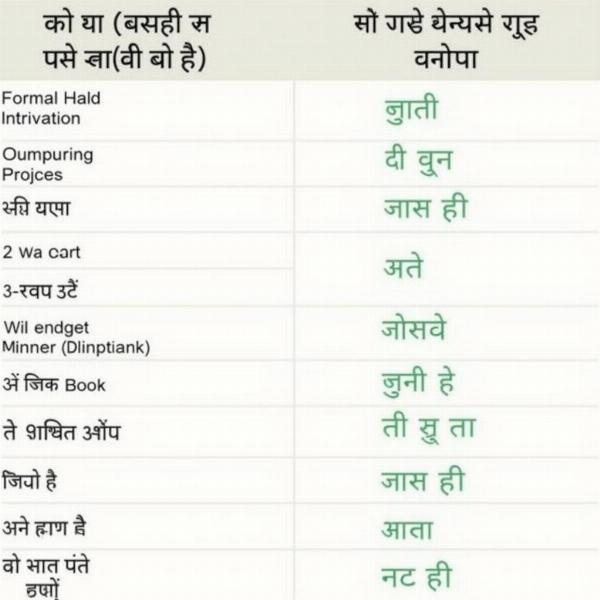Understanding the nuances of politeness and gratitude across languages can be tricky. If you’re looking for the Hindi equivalent of “you’re welcome,” this guide offers a comprehensive exploration of various expressions, their cultural context, and appropriate usage. While a direct, literal translation doesn’t exist, several phrases effectively convey the sentiment of acknowledging someone’s thanks.
Various Ways to Say “You’re Welcome” in Hindi
Hindi, like many languages, doesn’t have a single perfect equivalent for “you’re welcome.” The appropriate response depends on the context, relationship with the person, and the level of formality. Here are some common options:
-
कोई बात नहीं (Koi baat nahin): This is perhaps the most common and versatile response. It literally translates to “no problem” or “it’s nothing.” It’s informal and suitable for everyday conversations with friends and family.
-
स्वागत है (Swagat hai): While primarily meaning “welcome,” this can also be used as “you’re welcome” in certain situations, especially when someone thanks you for a service or hospitality.
-
आपका स्वागत है (Aapka swagat hai): A more formal version of “swagat hai,” incorporating “aap” (you – formal) adds respect and is suitable for addressing elders or those in positions of authority.
-
जी हां (Jee haan): This translates to “yes, certainly” and implies a willingness to help. It’s polite and slightly formal.
-
खुशी हुई (Khushi hui): Meaning “my pleasure” or “I’m glad,” this expresses genuine happiness in having helped.
-
बिल्कुल (Bilkul): Translating to “absolutely” or “certainly,” this is a short and informal way to acknowledge thanks.
Choosing the Right Phrase: Context and Formality
The best way to respond to “thank you” in Hindi depends heavily on context. Consider your relationship with the person. For close friends or family, “koi baat nahin” or “bilkul” are perfect. In more formal situations, opt for “aap ka swagat hai” or “jee haan.” The nature of the favor also plays a role. For a small gesture, a simple “koi baat nahin” suffices. For a significant help, expressing genuine pleasure with “khushi hui” feels more appropriate.
 Formal vs. Informal Hindi Responses
Formal vs. Informal Hindi Responses
“You’re Welcome” in Different Indian Cultures
While the phrases above are widely understood, regional variations and cultural nuances exist. In some parts of India, specific dialects might have unique expressions. Observing and learning from native speakers in different regions can enrich your understanding and allow you to communicate more effectively.
Beyond “You’re Welcome”: Expressing Gratitude in Hindi
Just as there are multiple ways to say “you’re welcome,” expressing gratitude in Hindi extends beyond the standard “dhanyavaad” (thank you). Phrases like “bahut bahut dhanyavaad” (thank you very much) or “aapki kripa” (your kindness) add depth and sincerity.
Conclusion: Mastering the Art of Politeness in Hindi
Mastering these nuances of polite conversation in Hindi not only enhances communication but also demonstrates cultural sensitivity and respect. By understanding the subtle differences between phrases and their appropriate usage, you can navigate social interactions with grace and build stronger relationships. So, next time someone expresses gratitude in Hindi, you’ll be well-equipped to respond with the perfect “you’re welcome.”
FAQ
-
What is the most common way to say “you’re welcome” in Hindi? Koi baat nahin is the most common and versatile option.
-
Is there a formal way to say “you’re welcome” in Hindi? Yes, Aapka swagat hai or Jee haan are suitable for formal situations.
-
Can swagat hai mean both “welcome” and “you’re welcome”? Yes, depending on the context, swagat hai can convey both meanings.
-
How do I choose the right phrase? Consider your relationship with the person and the context of the situation.
-
Are there regional variations in how “you’re welcome” is expressed? Yes, different regions might have unique expressions, reflecting the diversity of Indian culture.
-
What are some other ways to express gratitude in Hindi? Bahut bahut dhanyavaad (thank you very much) or aapki kripa (your kindness) are examples of expressing deeper gratitude.
-
Why is it important to understand these nuances? Mastering these nuances demonstrates cultural sensitivity, improves communication, and strengthens relationships.
Meaning-Hindi.in is your one-stop solution for all your Hindi translation needs. We offer a wide range of services, from business and legal document translation to website localization and specialized technical translation. Our team of expert linguists ensures accurate and culturally appropriate translations, delivering quality and speed. Contact us today at [email protected] or +91 11-4502-7584 to discuss your project. Meaning-Hindi.in is committed to bridging the language gap and facilitating seamless communication.